By Jeffrey A. Rendall; Photos By Kevin Gaydosh and Jeffrey A. Rendall
SOUTHERN PINES, NC – “You could easily say that Mid Pines is the only truly original Donald Ross golf course in the Pinehurst area,” said Chip King, Director of Golf at the Mid Pines Inn and Golf Club.
Does King speak heresy, or the truth? Either way, it’s a bold statement -- after all, Pinehurst #2 is just up the road, and Pine Needles (site of two US Women’s Opens and about to hold a third in 2007) is right across the street, and both are legendary Ross layouts. That’s not even considering the numerous other regional golf courses bearing Ross’s touch.
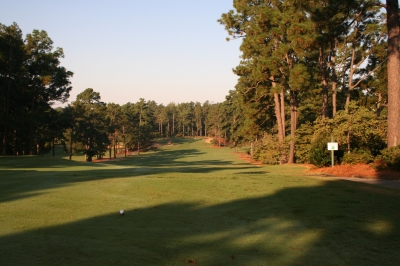 |
| Mid Pines' 1st tee has been in continuous use since 1921. It's where they used to start, and still do today. |
“Mid Pines opened in 1921, and has remained basically unchanged since then. Of course it’s a Ross original – he designed it and supervised its building. It’s the only golf course left in the Pinehurst area that is routed the exact same way that Donald Ross originally routed it. It’s safe to say, when you play Mid Pines, you’re as close to seeing a Ross original as you’re going to get,” King said proudly.
From the first hole through the eighteenth, you’re playing Mid Pines in the same order and shape that Ross originally put there. Number one tee is where it was in 1921, and the rest follows in equally consistent form. The trees have grown and the other effects of time and weather have done their inevitable work to alter the course, albeit subtly – but when you walk this course, you just feel that Ross’s ‘ghost’ is following a little closer behind you than anywhere else.
More than just an original, Mid Pines adds history – though probably not as distinguished as the above mentioned Ross courses. South African Bobby Locke won his first American tournament at Mid Pines in the forties, and Julius Boros won three major championships while serving as the club’s Head Professional (he married into the family that owned Mid Pines at the time). King still uses Boros’s desk – and it gets a fair amount more use these days than when Boros was in charge of it.
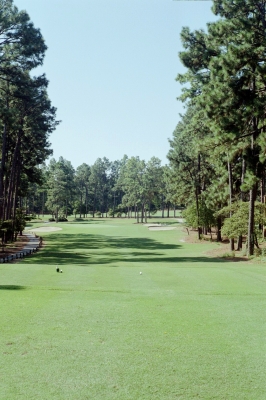 |
| The 223-yard par three 13th hole plays really long even today. It's hard to imagine what it must have been like trying to play this hole with hickory golf shafts and golf balls that didn't fly very far. |
Mid Pines also hosted the 2002 US Senior Women’s Amateur Championship, so the USGA’s been around on this side of Rt. 2 as well.
The course’s beauty and creativity would be well set for hosting other notable events, though it only measures a little over 6,500 yards from the absolute tips, so it’s already too short for major men’s tournaments. Having seen both, Mid Pines is a fair amount more aesthetically pleasing than its slightly younger sibling Pine Needles, but the latter course was recently restored and renovated to upgrade it to challenge the more modern golf games and equipment. Though Mid Pines is far from an ‘easy’ golf course, it’s more playable and friendlier to the occasional player – not that Pine Needles isn’t set up for duffers to enjoy.
Mid Pines is the place to be in the springtime as well, as King says it has more indigenous dogwoods than any other course in the area – and together with the plentiful blooming azaleas, that ‘other’ course in Augusta, Georgia certainly doesn’t have a monopoly on flowering beauty around the first part of April.
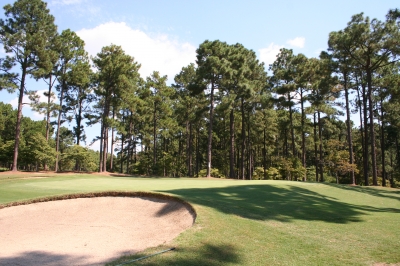 |
| Looking towards the 17th green -- Ross won't get you with tricks, but you will have to use your imagination to play short shots around the putting surfaces. |
The golf course plays like a Ross Course, but what exactly does that mean? King helps explain it: “Ross worked hard in all his designs to make sure that better players were challenged, yet those who weren’t as skilled could still come out and play the game and have fun. When you look at a Ross golf hole, he’ll almost always provide choices on how you want to play a shot. The emphasis is rarely on how hard and far you can hit the ball, but instead on how you need to assess every situation.”
That’s most evident around the putting surfaces. We’ve all heard how Ross’s greens are domed or turtle-backed, but that’s far too simple to characterize a man who wanted to emphasize skill with short shots – the ‘scoring’ shots in golf.
Again, King elaborates: “Ross wanted you to position your drive on a certain place on the fairway so it opened up the green to you – but even then, you had to think carefully about how you were going to play your next shot, because you can’t always aim right at the flag.”
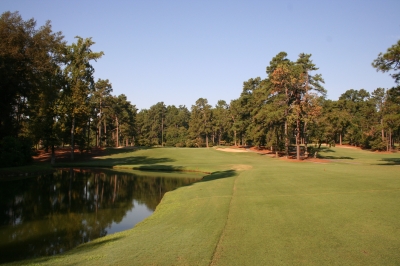 |
| Ross never put a lot of water hazards on his golf courses, but this pond heavily influences your decision on whether to lay-up or go for it on the par five 5th hole. |
It’s a principle that’s been adopted by all modern golf course designers – the concept of the ‘sucker pin’ and shaping greens to help steer approach shots towards the hole. At times you can knock the pin down with your shot and it’ll end up a lot farther away than it would have if you’d only aimed in the correct spot. Ross was the master of the concept of easy-bogey, difficult par, meaning the occasional players aren’t punished too severely for wayward accuracy, but the best players aren’t given a pass for failing to execute what the circumstances demand.
It also involves creativity with the short game. Mid Pines’ green complexes are tightly mowed, as they were originally intended to be, a throwback to Ross’s Scottish roots where deep, fluffy rough just wouldn’t grow in those types of conditions. Ross liked the ball played close to the ground, and you’ll work to come up with ways to best get your ball close to the hole when you miss a green.
“You can bump and run it, chip it, pitch it, hit it up into the air, or even putt it from 20 yards off the green. Very rarely is it all or nothing with Ross,” King said. “However, you need to decide where you’re aiming, because of the roll-offs on the edges. Most people think Ross designed greens that way to make it more difficult, but in those days, it was more of an engineering function than anything. Greens back then obviously didn’t have the complex drainage mechanisms that they do now – he just wanted to get rid of water.”
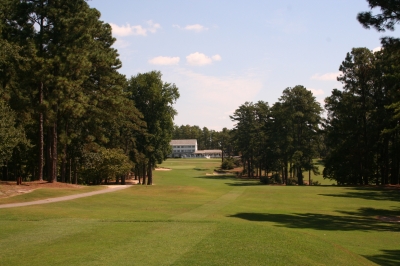 |
| Heading towards home on the 18th tee -- quite a grand conclusion to your round. |
“But those odd shaped greens have become a design feature now, especially with these newer strains of bentgrass that can be cut so short. It just adds an extra element of difficulty to every shot, knowing that if you’re not playing the right strategy, you can very easily be in a worse situation than from where you started,” King said, talking about how to deal with the rounded edges.
The ‘Open Doctor,’ Golf Architect Rees Jones once said the Ross-type greens are the only kind where short-siding yourself is actually a good thing, since you have more margin for error when playing back up towards the hole. It’s the truth, and that’s the type of thinking you need to employ at Mid Pines.
Seeing as another issue at more modern golf courses is pace-of-play, Ross, in all his infinite wisdom, took care of that as well – perhaps he was ahead of his time. King says that although you have to be careful around the greens, you can still keep moving – and Mid Pines is the epitome of a ‘core’ golf course, where the holes aren’t influenced by real estate. The tees are close to the previous hole’s green, and if you can’t walk a course like Mid Pines, you can’t walk anywhere. Walking is highly encouraged here, which is a breath of fresh air from your normal resort golf experience.
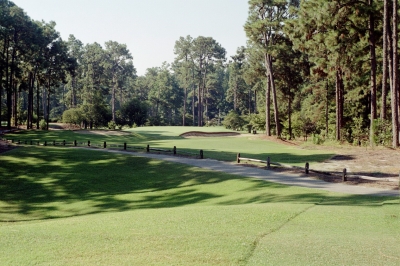 |
| Ross always puts a premium on controlling the distance on your iron shots. Going long is usually heavily punished, and that's never more true than here at the par three 8th hole. |
Because Mid Pines has had so little ‘modern’ intervention, its playing surfaces, at times, aren’t as pristine as some courses with the newer hybrid grasses. It’s not as noticeable to resort players, as you’ll certainly find Mid Pines in great shape. But it’s one area that would be addressed if and when Mid Pines goes under a restoration process, as Pine Needles recently did across the road. (Note: Both Mid Pines and Pine Needles are overseeded from treeline to treeline in the winter months, so they’re green year-round – one of the few facilities in the area that does this.)
King said it (restoration) is in the back of the owners’ minds – but right now most of the focus is getting Pine Needles ready to host another US Women’s Open in 2007. They’re tentatively hoping to get it done by the end of the decade, which would include completely re-grassing the course and restoring any bunkers that may have been added or removed during its nearly nine decades in existence.
It probably wouldn’t involve adding length, though. “You can have great shorter courses as well,” King added. Besides, there just isn’t the room to make it much longer.
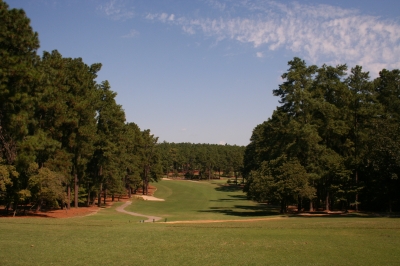 |
| You don't always think of elevation changes when you envision golf in the Pinehurst area, but sometimes it will surprise you, like here on the tee of the par four 16th hole. |
One other thing sets Mid Pines apart, a characteristic it shares with Pine Needles – they’re both owned by the Bell family, headed by Peggy Kirk Bell. Mrs. Bell is in her mid-eighties and is a fixture at the resorts, and her presence very much influences the personality and direction of the golf there.
“Whenever Mrs. Bell is in town, she’s here on a daily basis, and is very active in our instructional programs. She loves to interact with our resort guests – there’s rarely an evening that goes by where she doesn’t come and just greet folks and dine here. She’s a wonderful, charming lady and a walking history book,” King said.
She also lives along the 18th hole at Pine Needles, a fact that was pointed out by a playing partner who used to work at the resorts – and confirmed everything that King said about Mrs. Bell and her valuable presence. It just gives the experience more of a ‘family’ orientation, a nice friendly feeling when you’re there.
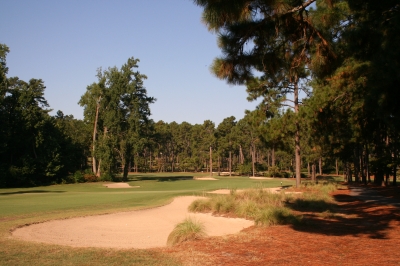 |
| You'll probably be surprised to see the 500-yard par five 6th hole is Mid Pines' #1 handicap hole -- but once you reach the well protected green, you'll understand why. |
Though every hole is memorable at Mid Pines, you’ll certainly remember the 223-yard, par three 13th hole. Though a lengthy par three is hardly rare on today’s golf courses, when you consider this hole’s length has only gotten ‘shorter’ (via the use of technologically advanced equipment) in the past 85 years, you’ll give new appreciation to the variety that Donald Ross created. 223 yards must’ve seemed like 350 back then – now that’s a par three. And it’s certainly no pushover today, either.
King pointed out that all four par threes at Mid Pines point in different directions and are of different lengths. The old Scottish master truly wanted to test every kind of shot, and the entire layout at Mid Pines is a study in Ross’s philosophy.
It’s a scholastic course of special originality as well, since you’ll play every shot exactly how he laid it out, all those years ago. And the conclusion you’ll come up with, is that Mid Pines is just as enjoyable now as it was intended to be back then. Ross’s spirit wouldn’t have it any other way.
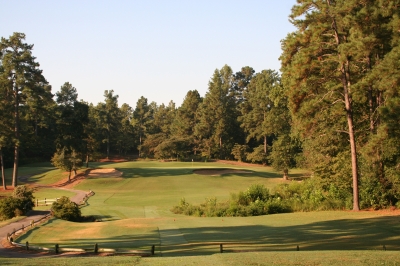 |
| Certainly one of the highlights at Mid Pines comes early in the round -- the par three 2nd hole. |
Staying at the Mid Pines Inn or the Pine Needles Lodge
Visiting Pine Needles and Mid Pines is more than just a golf experience. Though we’d say it’s primarily for golfers (the non-golf activities are somewhat limited), it’s hardly family un-friendly.
We stayed at the Pine Needles Lodge, which features 78 chalet-style rooms, including some suites. Most (if not all) overlook the golf course. There are 65 rooms across the road at the Georgian-style Mid Pines Inn, along with 45 more rooms in seven villas.
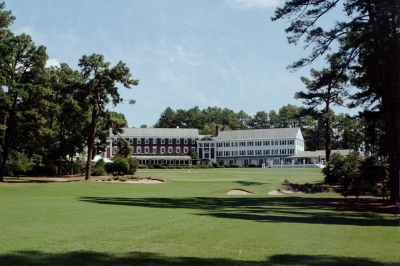 |
| The amphitheater surrounding Mid Pines' 18th green is major championship caliber -- in terms of beauty and quality. |
The buildings are older with solid construction, but what struck us the most was the sheer size of the rooms. Our room at the Pine Needles Lodge contained a large space for our sleeping quarters, but also ample closet space for an extended stay, and a sitting room where you could entertain a host of visitors. Perfect for families or groups, you can also enjoy patio space overlooking the golf course and driving range.
You won’t want for dining as well, as both Pine Needles and Mid Pines have dining rooms open for breakfast, lunch and dinner, and lounges for relaxing after a day spent on the links.
What’s especially noteworthy about staying at Pine Needles was the service and the attitude of the staff. Here’s where you’ll feel the presence of Proprietor Peggy Kirk Bell – every employee we came into contact with was graced and open with warm southern hospitality, and this includes the pro shop staff. If you don’t feel welcome here, well, you might not feel comfortable anywhere.
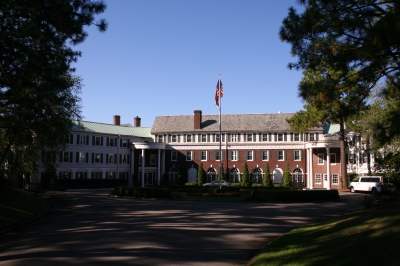 |
| The Georgian-Style Mid Pines Inn, built in 1921. |
To illustrate, our non-golfing members of the party (including two young children) arrived late for the breakfast serving, after posted hours. The staff extended the hours to accommodate them – something that was very much appreciated.
2005 US Open Champion Michael Campbell celebrated his victory with Mrs. Bell and the staff (check out the photos when you’re there) at Pine Needles. While other players couldn’t wait to get out of town, there was a reason why Campbell stayed – and if you stay at Pine Needles or Mid Pines, you’ll discover why you’ll want to hang around, too.
Details:
Mid Pines Inn and Golf Club
Southern Pines, NC 28388
Phone: (910) 692-2114
Reservations: (800) 747-7272
Website: http://www.pineneedles-midpines.com/; email: info@rossresorts.com
Course Designer: Donald Ross (1921)
Director of Golf: Chip King, PGA
Tees/Yardage/Slope/Rating (Par 72)
Blue: 6515 127/71.3
White: 6121 124/69.6
Red: 4907 120/68.2
Note: There’s a caddy program available on an advanced reservation basis.
To really get the Ross experience, try walking the courses. Walking is unrestricted, and trolleys or pull-carts are available for loan – or smaller, carrying-friendly golf bags if you prefer.
Rates:
‘Rack rate’ ranges from $100 in the winter to $225 to the high season, which is roughly April through June.
Consult the website. Packages also available with hotel accommodations at Pine Needles or Mid Pines.
| Related Links | Comments on this article? | |
|
Maryland National Golf Club Hollow Creek Golf Club Rocky Gap Resort PB Dye Golf Club in Ijamsville Whiskey Creek Golf Club |
E-mail Jeff Rendall, Editor: jrendall@golftheunitedstates.com |











